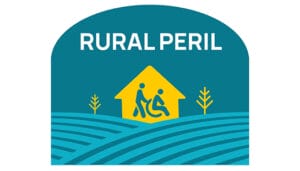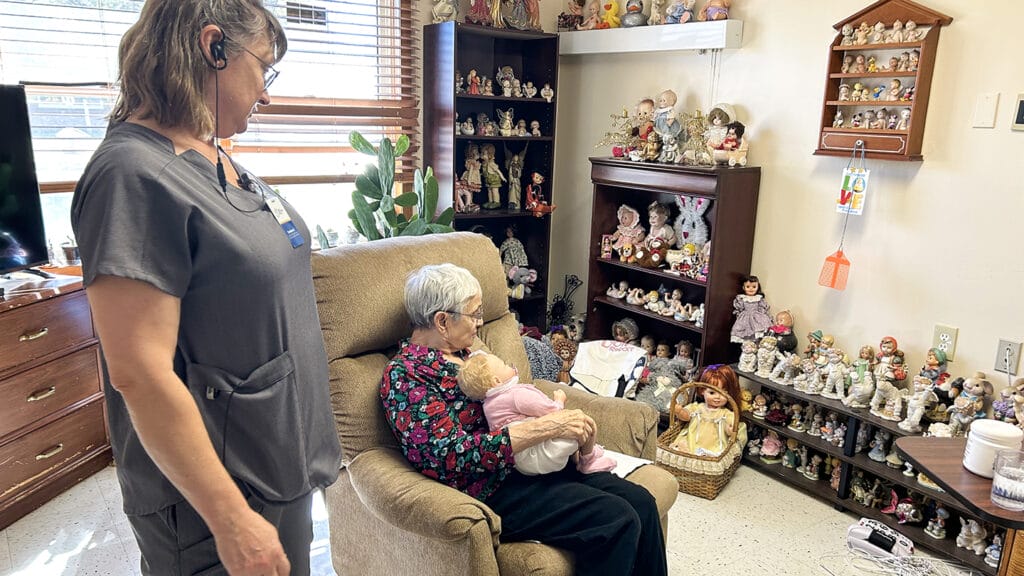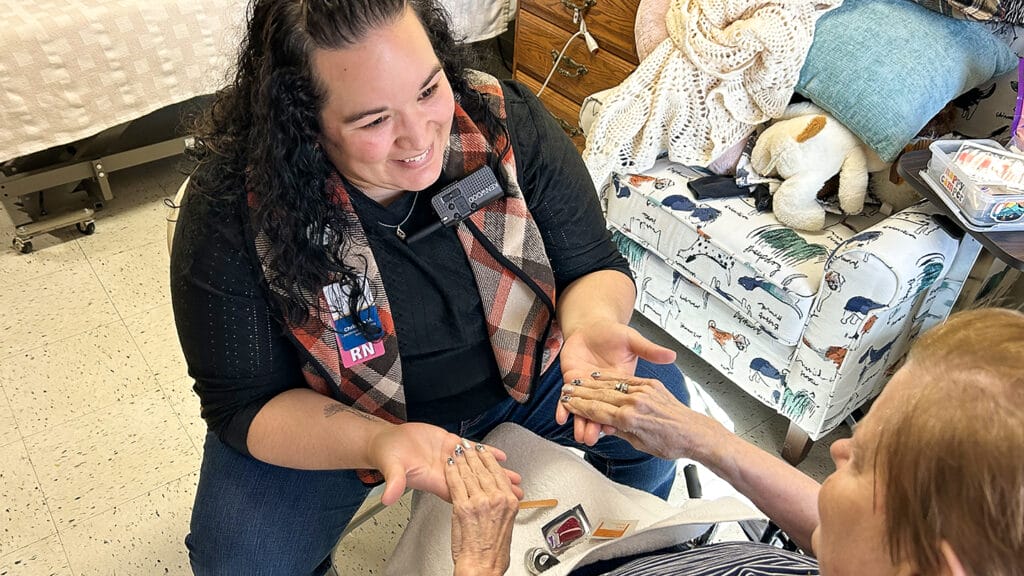
BLOOMFIELD, NE — For much of her working life, Candace Carey had been a caregiver to her own children while juggling jobs ranging from daycare assistant to receptionist.
But when she moved her mom, Margaret, to a skilled nursing facility closer to home and began visiting daily, Carey, 58, imagined herself in a new role. She offered to pick up hours if the facility were in need of a housekeeper, and then she enrolled in classes to become a certified nursing assistant just in case an opening became available.
In August, Carey left her job of eight years — monitoring eggs at a nearby chicken farm for nearly $18 an hour — and instead took a pay cut to watch over and tend to human beings.

“It’s such a rewarding job, but there are just not enough people out there who want to do it. I don’t know if it’s because of the money or because of the demands [of the job]” Carey told a McKnight’s Long-Term Care News reporter who visited Good Samaritan Society-Bloomfield. “I probably couldn’t work here and support myself, but I’m one of the lucky ones: I have a husband.”
Non-traditional hires like Carey offer providers hope in a time of deep despair. The sector was short 148,700 workers in late 2023 and could need to hire an additional 102,000 full-time employees under a proposed federal staffing rule, according to industry estimates.
Rural skilled nursing providers have been among the most deeply affected by pandemic-era losses, a fact acknowledged by a provision in the mandate that gives them two extra years to hire needed staff.
Providers lament limited labor pool
Mark Parkinson, president and CEO of the American Health Care Association, has called staffing “the metric that will matter most” for rural healthcare over the next five to 10 years.
“When you look at that metric in skilled nursing facilities, we have a particular problem,” Parkinson said. “There are a finite number of nurses and certified nurse aides and occupational therapists … and unfortunately, that number may be declining.”
That’s partly because many rural towns are losing population: From 2010 to 2020, some 970 of the nation’s 1,336 rural counties lost at least 5% of their residents. That rate tripled the previous decade’s shift.
That flight to the suburbs, as well as policy and reimbursement that have failed to keep up with shifting demographics, have led to healthcare “deserts.” They’ve also set up a situation that pits interdependent hospitals and nursing homes against each other when competing for caregiving staff.
In many rural locations, a lack of nursing home staff means hospitals struggle with timely discharges of patients needing post-acute care — at a cost that can average $1,000 a day.
“We’re all competing for the same people,” said Alan Morgan, CEO of the National Rural Health Association. “Not surprisingly, staffing requirements ramp up the issue for rural facilities. It makes the potential to keep rural nursing homes open extremely problematic, and it makes it even more difficult on the financial end to keep rural hospitals open.”
Mandate realities
The staffing mandate proposed by the Centers for Medicare & Medicaid Services would require 102,000 additional workers and $6.8 billion in annual spending, according to an analysis commissioned by AHCA. Federal regulators want all nursing homes to have round-the-clock RN coverage, provide 0.55 hours per patient per day of RN care, and 2.45 hours of daily CNA coverage for every patient.
“Given that there are fewer rural LTC facilities and a higher percentage of rural LTC facilities have greater distances between neighboring facilities, if a facility was not able to comply with the staffing requirement, it can have a more pronounced impact on access of care,” CMS acknowledged in its proposal.
The agency estimated that rural providers would be on the hook for an additional $1.27 billion in costs just for the first 10 years of required 24/7 RN coverage. It also expects facilities will need more time to comply, and it included a waiver process that would allow those that can’t find RNs to seek exemptions.
Nationally, the mandate would require more than 80,000 new nurse aides and 22,000 new RNs for nursing homes, according to an AHCA analysis. Each position has unique hiring challenges and vastly different competitors.
The questions on everyone’s mind are: Where will these new nurses come from and who will pay for salaries that just keep ratcheting up as demand increases? For many, the only real options are hiring costly temporary or agency staff or luring them away from hospitals that also need them.
Nursing homes might be able to recruit more entry-level workers like Carey if they weren’t competing against the higher wages offered by restaurants and retailers that hiked pay to respond to inflation. Instead, they struggled through several years in which Medicaid pay lagged behind extreme wage inflation.

Carey and her co-workers are acutely aware of their administrator’s struggle to balance the revenues coming in against the cost of hiring and retaining staff. It feels like an unfair situation to be in simply because their building has a smaller population to pull from.
“Everything is based on hours and occupancy, but each resident requires a different kind of care,” Carey said. “My mom is pretty independent, but there are some residents where you have to spend 15 to 20 minutes with them, and when there’s only one CNA, and there’s the radio going off and lights going off, you’re only one person. These CNAs, they need help.”
While some rural facilities provide free training to help grow their own CNAs, that delivers mixed results. Bloomfield Director of Nursing Services Christina Mahoney has seen only one candidate since she moved into her new role last July; the candidate quit on the second day.
In pursuit of RNs
Nurse aides can train in as little as two weeks. How these same facilities might amass thousands of higher-educated RNs in time to comply with a mandate within five years is really anyone’s guess. An RN degree is typically completed in two or four years of full-time schooling.
And nursing schools are turning out fewer RNs, with enrollment starting to slide in 2021 as many faculty retired due to COVID. Even when students do go away to nursing school, few are motivated to move to or return to rural America for work.
Mahoney trained in Iowa and came back to rural Nebraska to be close to family. Without that link, she might not have ended up at Bloomfield, where she has been a nurse off and on for the last six years. Since becoming the DNS, she has at times been the sole RN, even working every single day last August when agency staff were unavailable.
Trying to find fellow nurses remains a top priority; she has hounded friends, retired nurses and those who left for other fields to come work with her.
According to an internal Good Sam analysis, Bloomfield would need to hire three additional RNs and three CNAs to comply with the mandate. Across the organization, which is scaling back to seven mostly rural states, facilities would need to hire 215 additional RNs and 398 additional CNAs.
In Nebraska, providers will have to recruit in the face of major RN shortages. Nine of its 93 counties have zero RNs in any setting, while another three have only one, according to LeadingAge Nebraska CEO Kiertin Reed. Statewide, 6.3% of RNs work in nursing homes. Those who play key roles are so “overwhelmed” amid the current shortages, Reed said, that statewide tenure for a SNF director of nursing averages only 17 months.
For Mahoney, the stress of having to find those additional nurses or risk fines and potential closure adds to the daily demands already weighing on her.

She’d like to have more RNs in the building, but she also wants her licensed practical nurses to count toward hourly standards — LPNs are conspicuously and completely absent from the initial CMS proposal. Mahoney sees the call for 24/7 RN coverage as overkill in a building like hers, where most patients are long-stay and fairly low-need.
Too few nurses, too much competition
Jill Gengler, administrator at Wisconsin’s 50-bed Chippewa Manor Nursing and Rehabilitation, said she feels “really strongly about having our RN in the building for constant assessment and oversight because we’re taking some pretty acute folks.” But even with that philosophy, she’s found she has to settle for an experienced LPN on the night shift.
Gengler previously worked in Colfax, WI, which has a population of about 1,500. But even with a population about 10 times larger in Chippewa Falls, the same problems persist. There simply aren’t enough nurses in her area to cover existing need.
“We’re not drawing people in from more than a 10- or 15-mile radius, so recruiting can be really difficult,” Gengler confirmed. “We have a lot of competition. There are three hospitals in our community and, of course, their wages and their wage scale, it’s just not something we’re able to come close to.”
She’s also competing with major manufacturing centers that offer higher wages and full-time work split over three days, a flexibility that nursing homes can’t necessarily match.
But even if pay were the deciding factor for RNs, nursing home providers in rural states (and across the US) say they remain at a distinct disadvantage compared to hospitals with more favorable reimbursement policies. The Bureau of Labor Statistics reported late last year that the mean hospital RN salary is $90,600, while the same job in a nursing home nets an average of $77,190.
Mahoney’s father became a nurse a little over a year ago. Working at a hospital in Sioux Falls, SD, he’s already making the same hourly rate she is.
She and her colleagues were astounded to learn that the CMS mandate would require significant hiring but provide no additional funding to individual nursing homes or states.
“Where is the justice there? Why don’t we get to pay our nurses more? Why don’t we get to pay our aides more?” Mahoney asked. “The aides put in the work. They put the dirty work in, the heavy lifting, literally, and they need to be paid. I do my best to make sure they get paid or appreciated or told they’re doing great, but words can only go so far.”
Patchwork solutions
Despite their desperate pleas to CMS to abandon the mandate, many organizations are getting creative in their attempts to hire and retain.
“This is a very tense situation all around,” said Robyn Stone, LeadingAge senior vice president of Research and co-director of Long Term Services and Support at UMass. “There’s no great solution for any of this, but I do think that we need to be paying more attention to good practice in the nursing homes, and how do we use staff to advance best practices?”
Good Sam has developed a nursing council to be more responsive to staff needs as it designs new incentives. The company also relaunched its administrator-in-training program to develop stronger building leaders, who are shown to improve staff retention.
LeadingAge Nebraska last year started an eight-month Nurse Leadership Academy to strengthen the DON workforce through additional education and peer support.
Others are focusing more broadly on getting people into the field, even in the early stage of nurse development. For those individuals, Stone said, wrap-around services like transportation subsidies or childcare can be critical.
Those patchwork programs, though, only help the providers who fund them. Ideally, Stone said, the federal government would make a long-term investment to address worker shortages in identified target areas without a large enough pool or job candidates.
“Can you identify these shortage areas and then figure out either a two- or three-year program for people who are willing to either return there or move there?” she asked. “You’re not going to have people, necessarily, who are going to move back for the rest of their lives, but you could have it for sustained periods as they do with physician shortages and hospital shortages.”
A loan forgiveness program could be used to entice nurses to nursing homes and rural locations, specifically, Stone said, and so, too, could a Peace Corps-like rotation.
That theory is being tested in Kentucky, where officials have launched a Health Corps program to place 200 part-time workers in 50 healthcare facilities that support seniors and people with disabilities.
Modeled after AmeriCorp, students volunteer for two years, after which they have more options to enter healthcare or seek higher education. Such exposure to senior care is critical for recruitment, said Mahoney, who hears all the time from candidates who think skilled nursing is a boring job.
“It’s not,” she said. “Every day is a new adventure. I have a lady across the hall who was so routine all the time, and now she’s not. So we have to figure this out. What is going on? Let’s jump in and use our critical thinking and get this done, and I have 12 hours to do it, and I’m taking care of 26 other people. Long-term care is hard-core care.”
Like many, Mahoney envisions her operation going under should the mandate come into play as it’s currently outlined. While her RN skills would likely find her snatched up by another employer, her residents will have fewer choices: move to the next closest nursing home 30 minutes away; seek hard-to-find home care resources; or return home and depend on family caregivers for support.
“People in many of these rural communities like being fiercely independent and they grew up in these small towns,” added Good Samaritan President and CEO Nate Schema. “They’re dedicated to the lifestyle of being in a rural community and that means taking care of one another and taking care of each other’s families. Upwards of 60% of who we serve are on Medicaid services. That’s an indication that many of these residents, they don’t have infinite resources. If we’re not going to be there to serve them, then who will?”
Missed the first installment of Rural Peril? Read it here. And look for the next installment on Monday, Jan.22.




